#director: dorota kobiela
Text
youtube
"THE PEASANTS tells the story of Jagna, a young woman determined to forge her own path within the confines of a late 19th century Polish village – a hotbed of gossip and on-going feuds, held together, rich and poor, by pride in their land, adherence to colourful traditions and a deep-rooted patriarchy. When Jagna finds herself caught between the conflicting desires of the village’s richest farmer, his eldest son and other leading men of the community, her resistance puts her on a tragic collision course with the community around her."
This upcoming film by director Dorota Kobiela is based on the Nobel Prize winning novel Chłopi (The Peasants) by Władysław Reymont. I haven't read the book but I'm very interested in this story just from the trailer alone. And very impressed with that painted animation technique. It looks like an insane amount of work!
17 notes
·
View notes
Photo

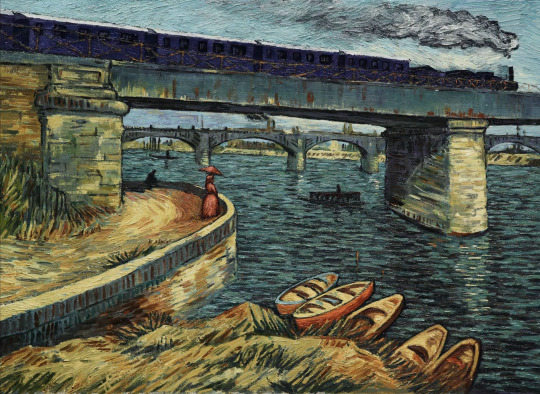
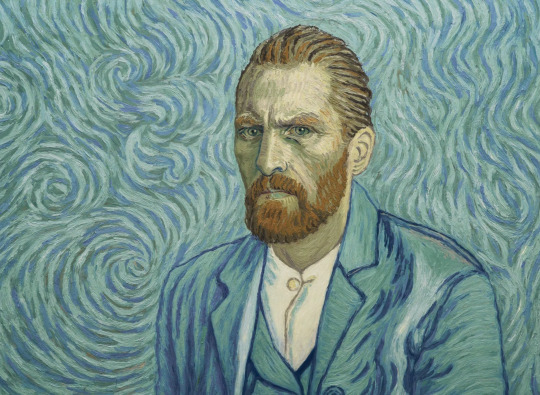


loving vincent (2017)
#loving vincent#film#movie#cinema#art#screencaps#animation#painting#2010s#aesthetic#female director#directed by women#dorota kobiela#hugh welchman#eleanor tomlinson#robert gulaczyk
297 notes
·
View notes
Text

Loving Vincent (2018) was co-written and directed by DK and Hugh Welchman. DK was born in Bytom, Poland, and has five director credits from 2010 (as Dorota Kobiela) to 2023.
DK's husband Hugh was born in Bracknell, England, and he also has a 2023 director credit.
It was Dorota's idea to make Loving Vincent. When drawing all the hand drawn images herself became impossible, she enlisted the help of her husband to help oversee the project.
1 note
·
View note
Text

Loving Vincent (2017)
Directors: Dorota Kobiela, Hugh Welchman
1 note
·
View note
Photo

Loving Vincent | Dorota Kobiela & Hugh Welchman | 2017
119 notes
·
View notes
Text
Animation Night 120: Richard Linklater and Bob Sabiston
Hi everyone! Apologies to friends back in Europe to be running so late today, I am afraid I’m on American time now.
And speaking of America... since I’m here I think I should probably show some American animation! Some American animation whose story is set right here in Orange County, California even.
[animation night archive]

Or more precisely, American rotoscopy!
So. Back on Animation Night 65, we shone a spotlight on the subject of rotoscopy!
Back then we saw how the rotoscope - the technique of drawing over live action film - was used extensively by Fleischer to animate the dances of jazz artists like Cab Calloway, then to a greater or lesser degree in many of the early films of Disney... and every so often revived for a new generation, e.g. by Ralph Bakshi in the 70s-80s, or a number of directors including Hiroshi Nagahama, Shunji Iwai and Dorota Kobiela and Hugh Welchman in the 2010s. [And closely related is of course motion capture (Animation Night 85), now a staple of CG animation.]
On that night I gave a brief mention to Richard Linklater, and the Rotoshop software of Bob Sabiston, but deferred that to another day. Well, that day is today!
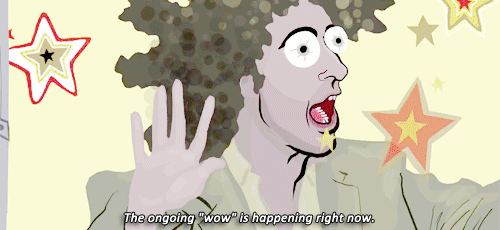
The tricky part of rotoscopy is that it involves a lot of drawing. So does animation in general, but the rotoscopy pipeline is a little different - you don’t have a division of key animation and inbetweening, and it’s a lot harder to figure out how to use labour-saving techniques like loops and hold frames.
There are other difficulties, like working out which features on a photo to turn into lines, and keeping this decision consistent even when those features go into shadow or otherwise become hard to identify in the video footage. Cleaning up rotoscope animation is not fundamentally different from cleaning up traditional animation, and may even be harder because there are many more features in the drawing - small bumps on a contour line for example - that must be kept consistent.
For these reasons, rotoscoped movies often end up having to compromise a bit - reduced framerates and lowered drawing detail as in Aku no Hana (The Flowers of Evil), or giving up on rotoscopy entirely and just putting in solarised video footage as in Bakshi’s The Lord of the Rings. Sometimes these work (I will absolutely die on the hill that Aku no Hana is good actually), and sometimes they don’t (sorry Ralph.)
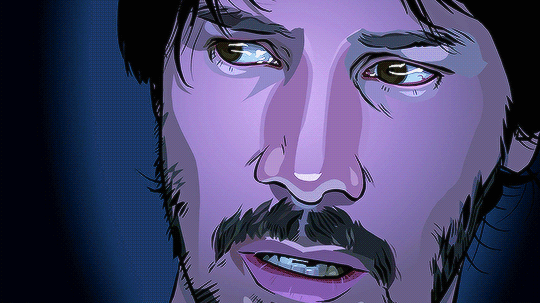
To try to make rotoscopy less time consuming while maintaining higher detail, former MIT researcher Bob Sabiston came up with a software called Rotoshop. The idea of Rotoshop is to help with interpolating vector animation: the artist can draw the extremes, and the program will match up the vector shapes in each frame and smoothly interpolate between them. If it doesn’t work right, the artist can tweak the parameters and try again.
This allows rotoscopy at high detail and a high framerate, with detailed visual elements like shadow and highlight shapes, plus the option to add a variety of digital textures and effects. The result is something that feels a little uncanny: you have the underlying 3D form of the actors coming through with startling clarity that would be nigh impossible in traditional animation, but all covered in oddly shifting vector shapes that don’t quite maintain their forms.
Sabiston got involved in animation during his time at MIT. Using early computer graphics, he created a number of short films such as God’s Little Monkey shown at the Siggraph Electronic Theatre in 1994, and Beat Dedication (1988) and Grinning Evil Death (1990), the latter two of which were shown on MTV’s Liquid Television block. I can only find GED, which you can watch here on youtube...
youtube
The film combines 3DCG and traditional animation credited to Sabiston, and you can see that he really knew what he was doing as an animator even at this point - handling a lot of tricky angles at honestly a very high framerate. I feel like some kind of digital interpolation must have been involved, unless Sabiston was just drawing like an absolute demon.
Sabiston released the first version of the Rotoshop software in 1997, and MTV was involved again as sponsors for the animation contest that motivated him. He used it to create a series of 30-second animations in New York called Project Incognito, followed by a short film called RoadHead in 1998 then Snack and Drink in and Figures of Speech in 1999. I believe I showed a few of those back on AN 65. Frustratingly, someone seems to have chopped Figures of Speech up into roughly nine second long clips which make it hard to determine if the full film has been uploaded anywhere, but here at least is Snack and Drink...
youtube
Compared to the films we’re about to look at, Snack and Drink features a constantly changing art style, interpreting the video in a different way every few seconds. It made a tour of film festivals, and presumably at some point caught the eye of director Richard Linklater, the other character in our story.
So, Linklater! This particular Richard grew up in Texas, and dropped out of school... not to animate but to work on an oil rig, where he got into novels, which developed in turn into a love of film when he returned to land and found a repertory cinema in Houston. So, he bought himself a Super-8 with his savings, founded the Austin Film Society with a number of academics and a SXSW founder, and started shooting short films in 1985, around the age of 25.
These early films were mostly short experimental films. In 1988, he finished his first feature film, It’s Impossible to Learn to Plow by Reading Books, a sizable undertaking; a Wikipedia editor writes...
a Super-8 feature that took a year to shoot and another year to edit. The film is significant in the sense that it establishes most of Linklater's preoccupations. The film has his trademark style of minimal camera movements and lack of narrative, while it examines the theme of traveling with no particular direction in mind. These idiosyncrasies would be explored in greater detail in future projects.
His next two films, Slacker (a day in the life of ‘misfits and bohemians’ in Austin) and Dazed and Confused (a day in the life of a bunch of high schoolers on their last day), were similar: low-budget comedy-drama films drawing on his life, that saw cult success as Linklater toured film festivals. The next few, like SubUrbia (1996) and The Newton Boys (1998) - his ‘first Hollywood feature’ about a family of bank robbers - weren’t so successful, but it seems he was undeterred...

So, where does this come to animation? That turn comes in (engage echo) the new millenium, with Linklater turning to a 20 year old idea that he hadn’t quite figured out how to handle:
I think to make a realistic film about an unreality the film had to be a realistic unreality.
Sabiston’s software held the answer. Linklater and Sabiston (between them, I guess, my sources are contradictory) gathered thirty artists from around Austin, and assigned them different segments of the film so it would have a shifting style like his short films.
What’s it like, about? Waking Life is about a boy passing through an ethereal series of environments having philosophical and literary discussions with the various people he meets, gradually realising that he is in fact in a dream that he cannot wake from. As he starts to dream lucidly, he starts to despair at his inability to escape this solipsistic world...
Other scenes do not even include the protagonist's presence but rather focus on a random isolated person, a group of people, or a couple engaging in such topics from a disembodied perspective. Along the way, the film also touches upon existentialism, situationist politics, posthumanity, the film theory of André Bazin, and lucid dreaming, and makes references to various celebrated intellectual and literary figures by name.

The visuals of course do a lot to help lend the film a suitably surreal mood - there is in a sense an underlying ‘reality’, showing through in the hard-to-draw perspectives and rotations, and yet it’s a view that’s constantly jittering and shifting and made of hard-edged shapes.
After this film found a large success, Linklater and Sabiston went their separate ways for a while. Sabiston continued to make short films with Rotoshop, including Yard, Earthlink Sucks, Grasshopper and a collection of shorts for Life360 on PBS, as well as a taking segment in the von Trier film Five Obstructions in which von Trier was challenged to shoot the same sequence with various gimmicks. Linklater meanwhile returned to live action, directing Tape (2001), School of Rock (2003), Before Sunset (2004) and Bad News Bears (2005). With a couple of mainstream comedies under his belt, he started to get more widely known.
So, A Scanner Darkly. This is based on the 1977 semi-autobiographical novel by famed science fiction author Philip K Dick, set in a near-future dystopian version of Orange County (where i’m staying!!! spooky) and following a group of heavy drug users. Per Dick’s account, it’s only lightly fictionalised, with its ‘Substance D’ taking the role of Dick’s use of amphetamines.

During this time, Dick lost a number of friends to the effects of heavy drug use in unsafe circumstances; his wife at the time Tessa Dick was heavily involved in supporting him. In fact, let me just quote the entire ‘background’ section from WP:
A Scanner Darkly was one of the few Dick novels to gestate over a long period of time. By February 1973, in an effort to prove that the effects of his amphetamine usage were merely psychosomatic, the newly clean-and-sober author had already prepared a full outline.[5] A first draft was in development by March.[6] This labor was soon supplanted by a new family and the completion of Flow My Tears, The Policeman Said (left unfinished in 1970), which was finally released in 1974 and received the prestigious John W. Campbell Award.[7] Additional preoccupations were the mystical experiences of early 1974 that would eventually serve as a basis for VALIS and the Exegesis journal; a screenplay for an unproduced film adaptation of 1969's Ubik; occasional lectures; and the expedited completion of the deferred Roger Zelazny collaboration Deus Irae in 1975.
Because of its semi-autobiographical nature, some of A Scanner Darkly was torturous to write. Tessa Dick, Philip's wife at the time, once stated that she often found her husband weeping as the sun rose after a night-long writing session. Tessa has given interviews stating that "when he was with me, he wrote A Scanner Darkly [in] under two weeks. But we spent three years rewriting it" and that she was "pretty involved in his writing process [for A Scanner Darkly]".[8] Tessa stated in a later interview that she "participated in the writing of A Scanner Darkly" and said that she "consider[s] [her]self the silent co-author". Philip wrote a contract giving Tessa half of all the rights to the novel, which stated that Tessa "participated to a great extent in writing the outline and novel A Scanner Darkly with me, and I owe her one half of all income derived from it".[9]
There was also the challenge of transmuting the events into "science fiction", as Dick felt that he could not sell a mainstream or literary novel after several previous failures.[citation needed][10] Providing invaluable aid in this field was Judy-Lynn del Rey, head of Ballantine Books' SF division, which had optioned the book. Del Rey suggested the timeline change to 1994 and emphasized the more futuristic elements of the novel, such as the "scramble suit" employed by Fred (which, incidentally, emerged from one of the mystical experiences). Yet much of the dialogue spoken by the characters used hippie slang, dating the events of the novel to their "true" time-frame of 1970–72.
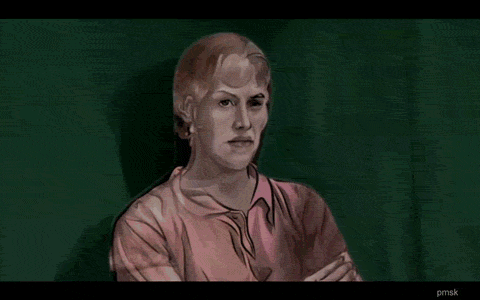
So a tough and very personal story to adapt, and at the time, Dick’s daughters Laura Leslie and Isa Hackett were hesitant to take further film adaptations after seeing what became of Minority Report and Paycheck. Linklater’s producer Tommy Pallotta wrote an entreaty to Dick’s agent Russ Galen, and after talking it over with Linklater, Dick’s daughters became convinced he wouldn’t treat it lightly and gave the go-ahead.
Despite Linklater keeping the budget small, the film involves a bunch of high-profile actors including Keanu Reeves, Robert Downey Jr., Winona Ryder and Woody Harrelson, all won around on the strength of the script. (Must have been a damn good script).
Still, we’re not here to talk about actors, we’re here to talk about aaaanimmattion! The film was shot in live action, with some unusual considerations. For a rotoscope film, it was not necessary to worry about things like mics appearing in shot, and the approach to lighting would be different - more important to give the rotoscopers enough information than to perfectly light its subjects for film. Rotoscopy also made it very straightforward to composite footage shot in Austin into backgrounds of locations in California.
Compared to Waking Life, this time Linklater wanted a much more detailed and consistent visual style... which was extremely tough for the animators, who had trouble getting to grips with the software and fell behind schedule. The answer to Linklater’s dissatisfaction was... unfortunately, crunch.
Animation and training for the 30 new artists had begun October 28, 2004. In late November, Mark Gill, head of Warner Independent Pictures, asked for a status report. There were no finished sequences, as the majority of animators were still learning to implement the film's highly detailed style.[2] Under pressure, some animators worked 18-hour days for two weeks in order to produce a trailer, which seemed to appease Gill and Linklater.[2]
After this it got rather worse. The animation fell behind its punishing six-month(!) schedule, straining the budget; in answer to this, Pallotta changed the locks while Sabiston and his team were out at lunch, and replaced them with two new artists, crediting all the original team leaders (Patrick Thornton, Randy Cole, Katy O’Connor and Jennifer Drummond) as ‘additional animation’ despite the fact they basically did the entire pre-production.
Following thi quick disappearing-commissaring of the animation team, the parent studio extended the animation period and increased the budget; Pallotta installed himself in charge, and ran things a lot more strictly, ‘Disney style’, with shorter segments, deadlines, and a style manual. In the end the animation still took 15 months in total.
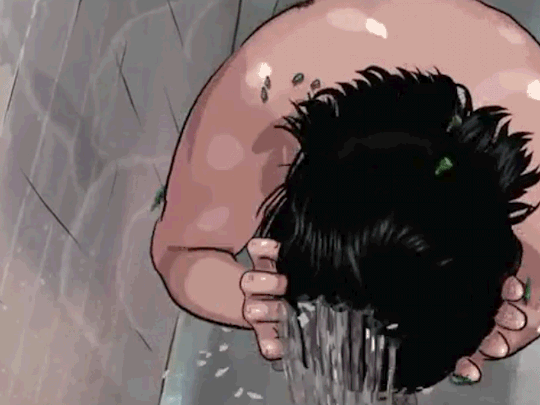
The result of all this effort is a film that really doesn’t look like many others, with complex blocky vector shadows that are constantly shifting over oddly perfect drawings which capture all the little bumps and contours in the human body in a way that would be nigh impossible for even the greatest animators from observation or imagination. The line style... I think also uses vector shapes to have a sense of tapering line weight, with the figures themselves outlined at the contour and significant folds, but interior shapes like hair often lineless.
And most significant is of course the incredibly detailed lighting - hard-edged like cel-shading but with many more layers and gradations of colour. The result is actually oddly flattening, since the shadow and highlight shapes are tracking underlying soft edges, so inevitably they become a little inconsistent. It’s a fascinating style and seems appropriate for a kinda surreal story where everyone’s taking a lot of drugs.
The film landed to ultimately mixed reviews; the people who liked it really liked it, while the detractors felt it went nowhere despite a lot of dialogue. Which means... after the struggles in production, it is probably going to be the last movie of its kind. I’d imagine any future rotoscope movies are more likely to use AI ‘style transfer’ filters to get the effect, rather than drawing over each frame this way.
So! Two fascinating and very distinctive films, both of which I’m very curious to experience at last. If you’d like to join me, they’ll be playing over at twitch.tv/canmom in about half an hour - please drop in chat and let me know when you’re here!
10 notes
·
View notes
Text










Existential Crisis in Movies
Fight Club (1999)
Director: David Fincher
Adapted from: Fight Club by Chuck Palahniuk
Dark (2017-20) TV Series
Created by - Baran bo Odar, Jantje Friese
Eternal Sunshine of the Spotless Mind (2004)
Director: Michel Gondry
Endless Poetry (2016)
Director: Alejandro Jodorowsky
Pyaasa (1957)
Director - Guru Dutt
Last Love (2013)
Director: Sandra Nettelbeck
Adapted from: La Douceur assassine
The Hours (2002)
Director: Stephen Daldry
Adopted from 1998 novel by Michael Cunningham.
Loving Vincent (2017)
Directors: Dorota Kobiela and Hugh Welchman
Rumble Fish (1983)
Director: Francis Ford Coppola
Skins (2007) cassie
Created by - Bryan Elsley, Jamie Brittain
#flims#movies#shows#tv series#film stills#series scenes#stills#series quotes#movie quotes#aesthetic#existentialism#life questions#life struggles#characters#emotions#drama
17 notes
·
View notes
Photo



First-look images and trailer for Oscar-nominated Loving Vincent director Dorota Kobiela’s The Peasants have been presented. The film is due for release in 2022.
Based on the novel Chłopi by Nobel Prize-winning Polish author Władysław Reymont, the movie uses painted animation inspired by the works of the “Young Poland” art movement (1890-1918) to immerse audiences in the everyday dramas of a rural Polish village at the dawn of the 20th century. The book was originally published in four parts, each representing a “season” in the lives of its peasant characters, between 1904 and 1909. The movie’s story will center on the tragic character of Jagna, a 19-year-old woman.
youtube
73 notes
·
View notes
Text









🎥: Loving Vincent (2017) ✨
• Directors: Dorota Kobiela, Hugh Welchman
• Cinematographer: Łukasz Żal
• Rotten Tomatoes: 85%
• Cast: Robert Gulaczyk, Saoirse Ronan, Douglas Booth, Eleanor Tomlinson, etc ...
#loving vincent#vincent van gogh#films#cinema#cinematography#saoirse ronan#film frames#film#cinematic#shots#aesthetic#movies#film stills#classic film
131 notes
·
View notes
Audio
Ask Me Anything! Your questions answered!
Women Direct the podcast is going on hiatus, but not before I answer your questions!
I nerd out with a very special mystery guest and name drop enough films to keep you occupied during the hiatus. What are you waiting for? Start watching!
Don’t forget to follow me on Twitter, Instagram, or to support me on Ko-fi!
You can subscribe to the podcast on Soundcloud, Apple podcasts and Spotify!
List of films and directors mentioned in this podcast:
Gett: The Trial of Vivian Amsalem dir. Ronit Elkabetz & Shlomi Elkabetz
The Governess dir. Sandra Goldbacher
Clip dir. Maja Milos
Seven Beauties dir. Lina Wertmüller
The Fits dir. Anna Rose Holmer
Vamps dir. Amy Heckerling
Romola Garai
Ellen Von Unwerth
Sophie Muller
Nikyatu Jusu
Mariama Diallo
Chloé Zhao
Dee Rees
Dorota Kobiela
The Piano dir. Jane Campion
Lost in Translation dir. Sofia Coppola
The Hurt Locker dir. Kathryn Bigelow
Lady Bird dir. Greta Gerwig
Children of a Lesser God dir. Randa Haines
Winter's Bone dir. Debra Granik
35 shot of Rum dir. Claire Denis
Beau Travail dir. Claire Denis
White Material dir. Claire Denis
We Need To Talk about Kevin dir. Lynne Ramsay
You Were Never Really Here dir. Lynne Ramsay
Wendy & Lucy dir. Kelly Reichardt
River of Grass dir. Kelly Reichardt
The Rider dir. Chloé Zhao
Toni Erdmann dir. Maren Ade
Zama dir. Lucrecia Martel
The Headless Woman dir. Lucrecia Martel
Fish Tank dir. Andrea Arnold
The Mourning Forest dir. Naomi Kawase
Girlhood dir. Céline Sciamma
Portrait of a Lady on Fire dir. Céline Sciamma
Marie Antoinette dir. Sofia Coppola
The Virgin Suicides dir. Sofia Coppola
Pariah dir. Dee Rees
Mudbound dir. Dee Rees
Dance Girl Dance dir. Dorothy Arzner
Cléo de 5 à 7 dir. Agnès Varda
La Pointe-Courte dir. Agnès Varda
Daisies dir. Vera Chytilová
The Ascent dir. Larisa Shepitko
My Brilliant Career dir. Gillian Armstrong
The Heartbreak Kid dir. Elaine May
Hester Street dir. Joan Micklin Silver
Crossing Delancy dir. Joan Micklin Silver
Portrait of Jason dir. Shirley Clarke
The Connection dir. Shirley Clarke
Jeanne Dielman dir. Chantal Akerman
The Hitch-hiker dir. Ida Lupino
Outrage dir. Ida Lupino
Wanda dir. Barbara Loden
Emma Autumn de Wilde
Zero Dark Thirty dir. Kathryn Bigelow
Victoria Mahoney
Ava Duvernay
Mulan dir. Niki Caro
#women direct the podcast#52 films by women#women in cinema#feminism#art#female filmmakers#female gaze#female film directors#cinema#film
19 notes
·
View notes
Photo
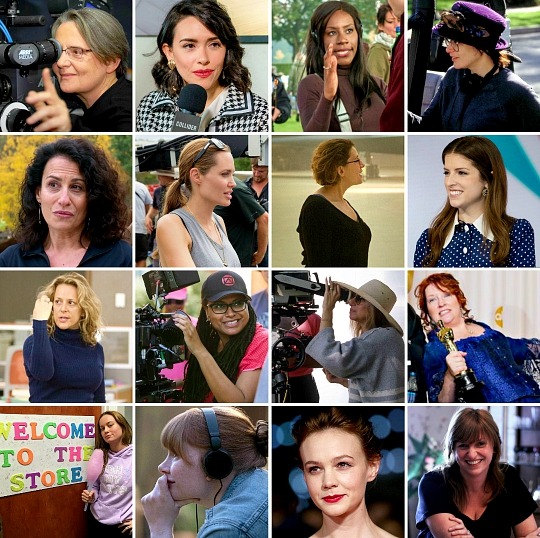


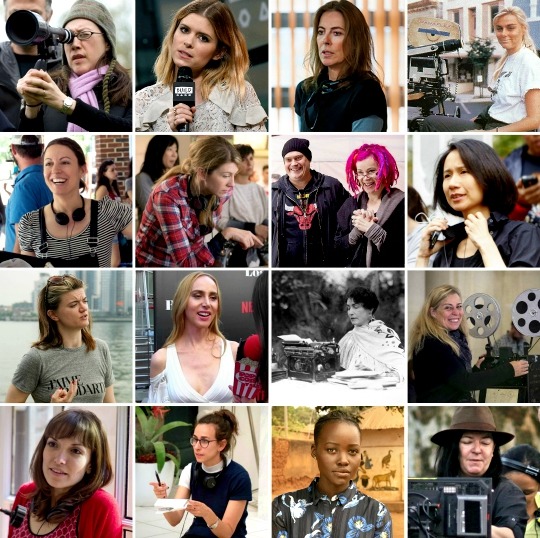
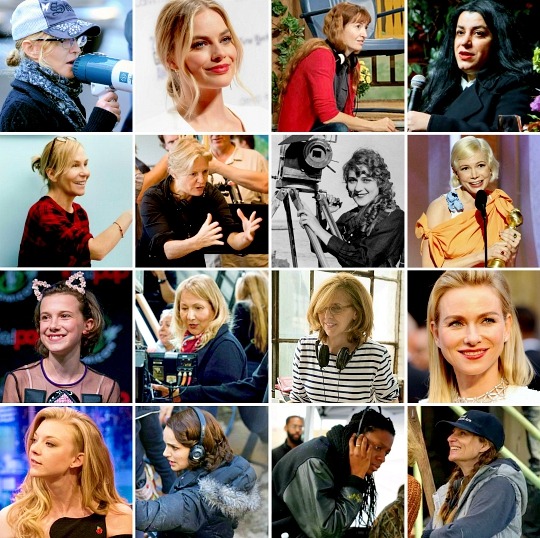
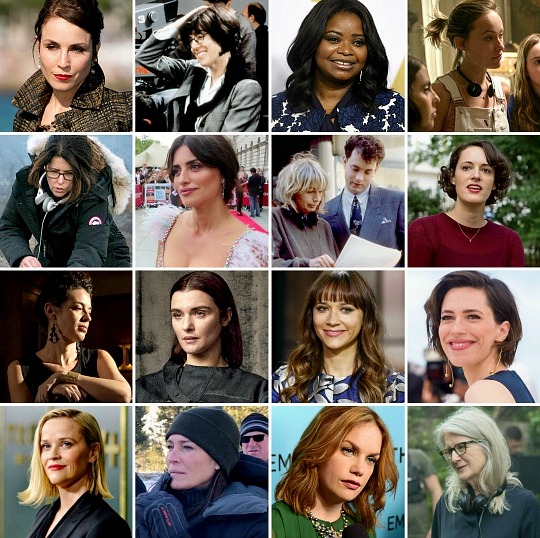

WOMEN IN FILM
Agnieszka Holland - director, The Secret Garden (1993)
Alice Waddington - director, Paradise Hills (2019)
Amma Asante - director, Belle (2013), A United Kingdom (2016)
Amy Heckerling - director, Look Who’s Talking (1989), Clueless (1995)
Angela Workman - writer, The Zookeeper’s Wife (2017), Longbourn (?)
Angelina Jolie - director, By the Sea (2015), First They Killed My Father (2017)
Anna Boden - director, It’s Kind of a Funny Story (2010), Captain Marvel (2019)
Anna Kendrick - exec. producer, Dummy (?), Love Life (?)
Anne Fletcher - director, The Proposal (2009), Dumplin’ (2018)
Ava DuVernay - director, Selma (2014), A Wrinkle in Time (2018)
Barbara Streisand - director, Yentl (1983)
Brenda Chapman - director, The Prince of Egypt (1998), Brave (2012)
Brie Larson - director, Unicorn Store (2017)
Bryce Dallas Howard - director, Dads (2019), The Mandalorian Ch. 4 (2019)
Carey Mulligan - exec. producer, Promising Young Woman (2020)
Cate Shortland - director, Lore (2012), Black Widow (2020)
Cathy Yan - director, Birds of Prey (2020)
Céline Sciamma - director, Portrait of a Lady on Fire (2019)
Chanya Button - director, Vita & Virginia (2018)
Charlize Theron - producer, Monster (2003), Atomic Blonde (2017), Bombshell (2019)
Chloé Zhao - director, Eternals (2020)
Claire McCarthy - director, Ophelia (2018), The Luminaries (?)
Debbie Allen - director, The Fresh Prince of Bel-Air (1990), The Twilight Zone (2003)
Deborah Chow - director, The Mandalorian Ch. 3, Ch. 7 (2019), Obi-Wan Series (?)
Debra Granik - director, Winter’s Bone (2010)
Desiree Akhavan - director, Appropriate Behavior (2014)
Diablo Cody - writer, Jennifer’s Body (2009), Young Adult (2011)
Dorota Kobiela - director, Loving Vincent (2017)
Drew Barrymore - director, Whip It (2009)
Elizabeth Banks - director, Pitch Perfect 2 (2015), Charlie’s Angels (2019)
Elizabeth Olsen - exec. producer, Sorry for Your Loss (2018–)
Emma Stone - exec. producer, Maniac (2018)
Emma Thompson - writer, Sense and Sensibility (1995), Last Christmas (2019)
Gal Gadot - producer, Wonder Woman 1984 (2020), Hedy Lamarr Mini-Series (2020–)
Gillian Armstrong - director, Little Women (1994), Death Defying Acts (2007)
Greta Gerwig - director, Lady Bird (2017), Little Women (2019), Barbie (?)
Gurinder Chadha - director, Bride & Prejudice (2004), Blinded by the Light (2019)
Jamie Babbit - director, Supergirl (2016), The Marvelous Mrs. Maisel (2018)
Jane Goldman - writer, Stardust (2007), X-Men: First Class (2011), Rebecca (2020)
Jennifer Lee - writer, Frozen (2013), Zootopia (2016), Frozen II (2019)
Jerusha Hess - writer, Napoleon Dynamite (2004), Nacho Libre (2006), Austenland (2013)
Jessica Chastain - producer, I Am Jane Doe (2017), 355 (2021)
Joanna Hogg - director, Unrelated (2007), Archipelago (2010), The Souvenir (2019)
Josie Rourke - director, Coriolanus (2014), Mary Queen of Scots (2018)
Julia Ducournau - director, Raw (2016), Titane (2020)
Julie Taymor - director, Frida (2002), Across the Universe (2007), The Glorias (2020)
Karen Gillan - director, The Party’s Just Beginning (2018)
Kari Skogland - director, The Falcon and the Winter Soldier (2020–)
Karyn Kusama - director, Æon Flux (2005), Jennifer’s Body (2009), Destroyer (2018)
Kate Mara - producer, My Days of Mercy (2017), A Teacher (2020–)
Kathryn Bigelow - director, The Hurt Locker (2008), Zero Dark Thirty (2012)
Katt Shea - director, Poison Ivy (1992), Nancy Drew and the Hidden Staircase (2019)
Kay Cannon - writer, New Girl (2012-2013), Girlboss (2017), Cinderella (2021)
Kelly Fremon Craig - director, The Edge of Seventeen (2016)
Lana & Lilly Wachowski - directors, The Matrix (1999), Cloud Atlas (2012)
Laura Lau - director, Silent House (2011)
Leslye Headland - writer, Terriers (2010), Bachelorette (2012), Russian Doll (2019–)
Lindsey Beer - writer, Chaos Walking (2020), The Kingkiller Chronicle (?), Silver Sable (?)
Lois Weber - director, A Heroine of ‘76 (1911), The Angel of Broadway (1927)
Lone Scherfig - director, An Education (2009), One Day (2011), Their Finest (2016)
Lorene Scafaria - director, Seeking a Friend for the End of the World (2012), Hustlers (2019)
Lucia Aniello - director, Rough Night (2017), Broad City (2014-2019)
Lupita Nyong’o - producer, In My Genes (2009), Americanah (2020–)
Lynne Ramsay - director, We Need to Talk About Kevin (2011)
Madonna - director, Filth and Wisdom (2008), W.E. (2011)
Margot Robbie - exec. producer, Gotham City Sirens (?), Modern Shakespeare Project (?)
Marielle Heller - director, A Beautiful Day in the Neighborhood (2019)
Marjane Satrapi - director, Persepolis (2007), The Voices (2014), Radioactive (2020)
Marti Noxon - writer, Fright Night (2011), To the Bone (2017), Sharp Objects (2018)
Mary Harron - director, American Psycho (2000), Alias Grace (2017), Charlie Says (2018)
Mary Pickford - writer, The Awakening (1909), Rags (1915), A Girl of Yesterday (1915)
Michelle Williams - exec. producer, Blue Valentine (2010), Fosse/Verdon (2019)
Millie Bobby Brown - producer, Enola Holmes (2020)
Mimi Leder - director, Deep Impact (1998), On the Basis of Sex (2018)
Nancy Meyers - director, The Parent Trap (1998), The Holiday (2006), The Intern (2015)
Naomi Watts - exec. producer, Gypsy (2017), The Wolf Hour (2019)
Natalie Dormer - writer, In Darkness (2018)
Natalie Portman - director, A Tale of Love and Darkness (2015)
Nia DaCosta - director, Little Woods (2018), Candyman (2020)
Niki Caro - director, Whale Rider (2002), The Zookeeper’s Wife (2017), Mulan (2020)
Noomi Rapace - producer, Stockholm (2018), Close (2019), Hearts of Stone (2020)
Nora Ephron - director, Sleepless in Seattle (1993), You’ve Got Mail (1998), Julie & Julia (2009)
Octavia Spencer - exec. producer, Green Book (2018), Self Made (2020–)
Olivia Wilde - director, Booksmart (2019)
Patty Jenkins - director, Monster (2003), Wonder Woman (2017), I Am the Night (2019)
Penélope Cruz - producer, Twice Born (2012), Ma ma (2015), The Queen of Spain (2016)
Penny Marshall - director, Big (1988), A League of Their Own (1992)
Phoebe Waller-Bridge - writer, Fleabag (2016-2019), No Time to Die (2020)
Quiara Alegría Hudes - writer, In the Heights (2020), Vivo (2021)
Rachel Weisz - producer, The Shape of Things (2003), Radiator (2014), Disobedience (2017)
Rashida Jones - writer, Black Mirror: Nosedive (2016), Toy Story 4 (2019)
Rebecca Hall - director, Passing (2020)
Reese Witherspoon - producer, Penelope (2006), Gone Girl (2014), Tinker Bell (?)
Robin Wright - director, House of Cards (2014-2018), Land (?)
Ruth Wilson - exec. producer, Mrs. Wilson (2018)
Sally Potter - director, Orlando (1992), The Man Who Cried (2000)
Salma Hayek - producer, Frida (2002), Ugly Betty (2006-2010), The Prophet (2014)
Sandra Bullock - exec. producer, George Lopez (2002-2007), The Proposal (2009)
Scarlett Johansson - exec. producer, The Whale (2011), Black Widow (2020)
Sofia Coppola - director, Lost in Translation (2003), The Beguiled (2017)
Susanna White - director, Bleak House (2005), Jane Eyre (2006), Woman Walks Ahead (2017)
Susanne Bier - director, Serena (2014), The Night Manager (2016), Bird Box (2018)
Tessa Thompson - exec. producer, Little Woods (2018), Sylvie’s Love (2020)
Thea Sharrock - director, The Hollow Crown: Henry V (2012), Me Before You (2016)
Thea von Harbou - writer, Destiny (1921), Metropolis (1927), Woman in the Moon (1929)
Tina Fey - writer, Mean Girls (2004), Unbreakable Kimmy Schmidt (2015-2019)
Valerie Faris - director, Battle of the Sexes (2017), Living with Yourself (2019–)
Vanessa Taylor - writer, Divergent (2014), The Shape of Water (2017)
Zoe Kazan - writer, Ruby Sparks (2012), Wildlife (2018)
Zoe Lister-Jones - director, Band Aid (2017), Woman Up (?), The Craft (?)
Zoe Saldana - producer, Rosemary’s Baby (2014), The Honor List (2018), From Scratch (2020–)
Zooey Deschanel - exec. producer, New Girl (2011-2018)
48 notes
·
View notes
Photo

Película: Loving Vincent (Cartas de Van Gogh)
País: Polonia
Director: Dorota Kobiela, Hugh Welchman
Año: 2017
Género: Animación, Biográfico
Año 1891. Un año después de la muerte de Vincent van Gogh, el cartero Roulin le pide a su hijo Armand que entregue personalmente la última carta de Van Gogh a su hermano, Theo, después de que sus intentos previos de enviársela hubieran fallado. A pesar de no haber apreciado a Van Gogh y recordar el incidente cuando el fallecido se mutiló su oreja y se la dio a una prostituta, Armand acepta con disgusto debido al afecto de su padre por el pintor...
Primer largometraje compuesto por pinturas animadas, "Loving Vincent" es un film homenaje a Van Gogh en el que cada fotograma es un cuadro pintado sobre óleo, tal y como el propio Vincent lo hubiera pintado. Sus 80 minutos de duración están compuestos por 56.800 fotogramas que han sido pintados, uno a uno, por una gran cantidad de excelentes pintores a lo largo de varios años, todos inspirándose en el estilo y arte magistral de Van Gogh.
Trailer: https://www.youtube.com/watch?v=bOtkQYVpVGQ
Película Online (subtitulada & doblada): https://www1.cuevana3.video/1963/cartas-de-van-gogh
2da opción (doblada): https://www.rexpelis.com/pelicula/loving-vincent
3ra opción: (doblada, Play en ventana emergente): https://repelis.me/pelicula/cartas-de-van-gogh-online-bvoWM
FESTIVALES:
2017: Premios Oscar: Nominada a mejor largometraje de animación
2017: Globos de Oro: Nominada a Mejor filme de animación
2017: Premios BAFTA: Nominada a Mejor película de animación
2017: Festival Internacional de Shanghai: Mejor película de animación
2017: Premios Annie: Nominada a mejor película independiente, guion y música
2017: Festival de Annecy: Premio del público
2017: Premios del Cine Europeo: Mejor largometraje de animación
2017: National Board of Review (NBR): Mejores películas independientes del año
2017: Critics Choice Awards: Nominada a mejor largometraje de animación
2017: Asociación de Críticos de Chicago: Nominada a mejor film de animación
2017: Círculo de Críticos de San Francisco: Nominada a mejor film de animación
2017: Satellite Awards: Nominado a mejor largometraje de animación
2017: Premios David di Donatello: Nominada a Mejor film de la Unión Europea
12 notes
·
View notes
Photo

Decadent—Best of the 2010s.
The best films and directors of the decade, according to the Letterboxd community. As the 2010s stumble to a close, we release a collection of lists celebrating the best films and directors of the decade, and reveal your most underrated and overlooked gems.
When Parasite overtook The Godfather this past November to become the highest-rated film of all time on Letterboxd, it was also confirmation of what we’ve been noticing since we launched the service in 2011: that the 2010s have ushered in a new golden era of filmmaking. Alongside the rise in blockbuster franchises, the film world has seen new innovations in genre films, financing models and talent pathways, helping a new generation of indie filmmakers to get traction in the competitive and unpredictable feature film scene.
And while the industry continues to reckon with upheavals in the studio system and theatrical landscape, the upside is that cinephiles have more and more platforms through which we can find and share new discoveries, back-catalog classics and obscure treasures. Indeed, our own recently launched partnership with JustWatch is helping many of you more easily track down and watch old favorites and recent releases. (JustWatch keeps track of streaming data for 38 countries and rising, and in the US alone, it monitors well over 100 services.)
In the spirit of discovery, and ahead of our 2019 Year in Review (coming in early January) we’ve run the numbers on the past decade of movies. Read on for the results—you have a couple of days left to squeeze some of them into your year’s viewing, in order to influence your 2019 and decade stats! (By the way, if you’re a Pro or Patron member, and you have best-of-decade lists for this or any other decade, you can now tag them so they appear on your all-time stats page. Use this format: top2010s, top1980s etc. We’ve also extended support for all-time top lists past the previous maximum of ten.)
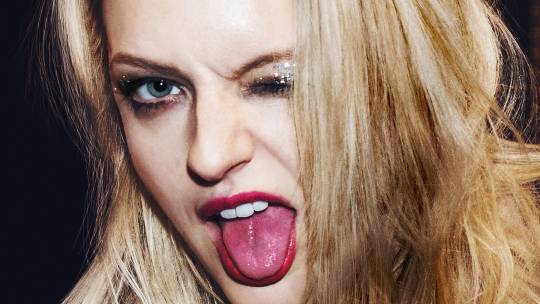
The Top 20 Uncut Gems of the 2010s
Each fortnight, we run a Showdown where you get to pick your favorite films for a given theme. For the final Showdown of 2019—and the decade—we asked you to list your favorite ‘uncut gems’ of the 2010s—the overlooked, under-seen, not-loved-enough movies that you think more people need to know about.
It’s been the most popular Showdown ever, with pages and pages and pages of lists worth exploring in their entirety. We added up the most-mentioned films, removed those that had been watched by more than 15,000 members (per the specific rules of this challenge) and arrived at a final top 20, with Alex Ross Perry’s messy rock drama Her Smell taking the top spot (read our write-up about the Elisabeth Moss-starring film here). It’s quite an international list, with six women directors (Josephine Decker, Agnieszka Smoczyńska, Kelly Reichhardt, Hélène Cattet, Cristina Gallego and Mélanie Laurent), two Ciro Guerra films from Colombia, and a film from the Safdie brothers, the directors behind Uncut Gems, which has an impressive 4.3 average on Letterboxd right now.

The Top 250 Narrative Feature Films of the 2010s
Parasite, Spider-Man: Into the Spider-Verse and Portrait of a Lady on Fire topped the highest-rated 250 narrative feature films of the 2010s. The busiest directors on this list were Denis Villeneuve and Taika Waititi, with five films each. Hirokazu Kore-eda, Martin Scorsese, Christopher Nolan, Wes Anderson, Quentin Tarantino and Lee Chang-dong all feature with three films each.

The Top 100 Directors of the 2010s
We set out to find the narrative feature film directors whose work in the 2010s, as ranked by the Letterboxd community, combined with their overall placing on our Top 250 of the 2010s list, signified their excellence in the directing field. After some data-heavy research, backed by a solid methodology, one name emerged at the top: Denis Villeneuve. Taika Waititi and Lee Chang-dong round out the top three.
Interestingly, only two Best Director Oscar winners from the 2010s made the list: Damien Chazelle and Alejandro González Iñárritu. The most prolific directors on the list are Hong Sang-soo (14 films) and Sion Sono (11 films).
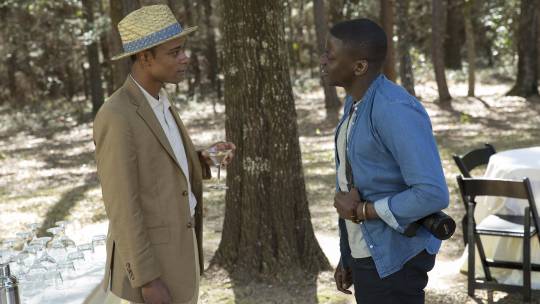
The 100 Most Popular Films of the 2010s
This list is determined by the films that have the most activity across our community, including watches, reviews, comments, list additions and more. Get Out topped this list, with Avengers: Infinity War and La La Land close behind.
This is a heavily US-based list, with very few films made outside the US and only two made primarily in non-English languages: Parasite and Roma. Christopher Nolan is tied for first place with the Russo brothers in terms of having the highest number of films on the list, at four each.
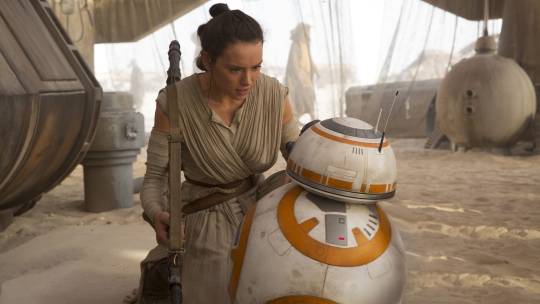
The Top 50 Most Obsessively Rewatched Films of the 2010s
By “obsessive” we mean total watches from all members who logged a film five or more times. The top three are: Star Wars: The Force Awakens, Avengers: Infinity War and La La Land. The Marvel Cinematic Universe accounts for a full 20 percent of the list (including the Guardians of the Galaxy films and Spider-Man: Homecoming, but not including Spider-Man: Into the Spider-Verse). The Star Wars franchise has six films on the list.
The Russo brothers, Anthony and Joe, are the MVPs of this list, with four MCU directing credits. Jon Favreau is represented all over the list as a director (Elf), a writer and a producer. And, of course, the late Stan Lee is credited across the MCU. We made an accompanying list for those who have Paddington obsessions.

The Top 100 Documentary & Non-Fiction Films of the 2010s
O.J.: Made in America is the top non-fiction title of the 2010s, while For Sama is the top feature-length documentary. The MVP of documentary directors is American great Frederick Wiseman, who has three films in the list. Joshua Oppenheimer, Agnès Varda, Steve James, Adam Curtis, Asif Kapadia, Petra Costa and the filmmaking duo Dan Lindsay and T.J. Martin all have two films apiece. 24 women directors feature in the list, across 26 films.

The Top 100 International Films of the 2010s
An incredibly strong list, this was topped—of course—by Parasite, with Portrait of a Lady on Fire and The Handmaiden completing the top three. There were some notable exclusions on this list, due to not having a US release date until 2020. They are: Bacurau, System Crasher, And Then We Danced, Vitalina Varela and Two Blue Stripes. Maybe we’ll see them in our 2020 round-up.

The Top 100 Animated Feature Films of the 2010s
This is a Japan-heavy list, with more than 35 films in the top 100. The US follows with 26 films, including the first-placed Spider-Man: Into the Spider-Verse. Don Hertzfeldt’s It’s Such a Beautiful Day is at number two and Lee Unkrich’s Coco takes third place.

The Top 100 Women-Directed Feature Films of the 2010s
A truly international cross-section of feature films is represented in this list, which is topped by Céline Sciamma’s Portrait of a Lady on Fire, one of three by the director to appear in the list. Greta Gerwig has an impressive two films in the top ten. Other directors to appear twice are: Kathryn Bigelow, Dee Rees, Lynne Ramsey, Marielle Heller, Andrea Arnold, Maren Ade, Juliana Rojas, Zoya Akhtar, Meghna Gulzar, Nadine Labaki, Kelly Reichhardt and Naoko Ogigami. More recent films feature heavily, with 22 from 2017 versus just one from 2013.

The Top 50 Directorial Debuts of the 2010s
We looked for the highest-rated feature film debuts by directors who had not helmed a film solo prior. We included directing partnerships where part of the collaborative team had not made a feature before; that’s why Peter Ramsey is in the mix alongside feature newcomers Rodney Rothman and Bob Persichetti, taking the top spot for Spider-Man: Into the Spider-Verse. Rounding out the top three are Don Hertzfeldt and Jordan Peele.
A full quarter of this list is comprised of women directors: Lulu Wang, Deniz Gamze Ergüven, Olivia Wilde, Dee Rees, Nora Twomey, Alma Har'el, Rebecca Sugar, Yoon Ga-Eun, Jennifer Fox, Shouko Nakamura, Dorota Kobiela and Naoko Yamada.
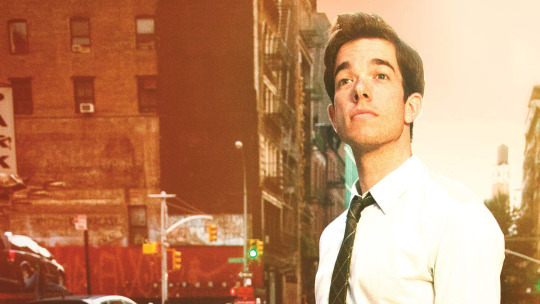
The Top 50 Comedy Specials of the 2010s
John Mulaney topped this list, with four specials included, and a fifth likely to make the list by year’s end. Fun fact: twelve of these were from 2017, which is double the next most represented year (six are from 2018). Un-fun fact: only five comedy women here.

The Top 50 Limited or Miniseries of the 2010s
David Lynch’s Twin Peaks took the top spot, closely followed by Craig Mazin’s Chernobyl, and When They See Us, Ava DuVernay’s dramatic series about the Central Park 5.
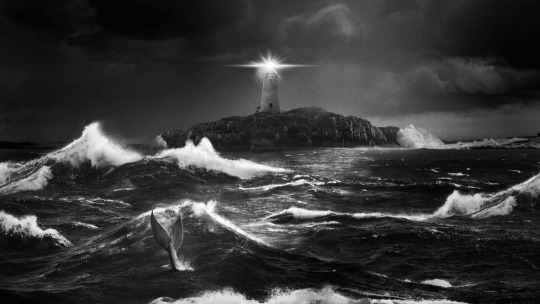
The Top 50 Horror Films of the 2010s
We made room for a single genre list, and horror was it—you’ll note we’ve erred on the generous side with what might be considered a horror film (so, yes, there are comedy horrors and psychological thrillers included). Robert Eggers’ The Lighthouse swept in late in the decade to take the top spot, while Get Out and What We Do in the Shadows also ranked highly.
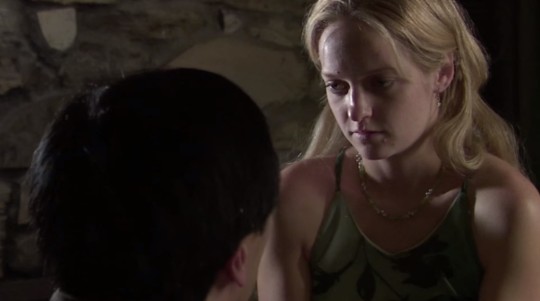
The 50 Most Divisive Films of the 2010s
These were the 50 most divisive feature films, concert movies, comedy specials and other curiosities of the 2010s. These are the titles from the 2010s that had the widest spread of ratings (note: this list has been updated using a more appropriate methodology and higher minimum viewer count since this post was published).
That’s all, folks. Huge thanks to Jack for compiling the lion’s share of these lists. We’ll see you in 2020 with our 2019 Year in Review. (All the decade best-of list rankings are provisional and will be finalized after 31 December.)
#the2010s#decade best of#best of decade#best films of the 2010s#best films of the decade#parasite#letterboxd
12 notes
·
View notes
Text
Film Journal - 2018
Because im done with the low quality screenshots lol
- Annihilation (2018) dir. Alex Garland
- Appropriate Behavior (2014) dir. Desiree Akhavan
- As Tears Go By (1988) dir. Wong Kar Wai
- Audition (1998) dir. Takashi Miike
- Barton Fink (1991) dir. Coen Brothers
- Burning (2018) dir. Lee Chang-dong
- Coco (2018) dir. Lee Unkrich, Adrián Molina
- Bram Stoker’s Dracula (1992) dir. Francis Ford Coppola
- El Clan (2015) dir. Pablo Trapero
- Get Out (2017) dir. Jordan Peele
- Isle of dogs (2018) dir. Wes Anderson
- La Chinoise (1967) dir. Jean Luc Godard
- Las Mantenidas sin sueños (2005) dir, Vera Fogwill y Martin Desalvo
- Love, Simon (2018) dir. Greg Berlanti
- Loving Vincent (2017) dir. Dorota Kobiela, Hugh Welchman
- Melancholia (2011) dir. Lars Von Trier
- My Own Private Idaho (1991) dir. Gus Van Sant
- Mystery Train (1989) dir. Jim Jarmusch
- Phantom Thread (2017) dir. Paul Thomas Anderson
- Pizza, Birra, Faso (1997) dir. Bruno Stagnaro y Israel Adrián Caetano
- Punch Drunk Love (2002) dir. Paul Thomas Anderson
- Saving Face (2004) dir. Alice Wu
- Saving Private Ryan (1998) dir. Steven Spielberg
- Singles (1992) dir. Cameron Crowe
- Sorry To Bother You (2018) dir. Boots Riley
- The Cloverfield Paradox (2018) dir. Julius Onah
- The Handmaiden (2016) dir. Park Chan-wook
- The Handmaid's Tale (1990) dir. Volker Schlöndorff
- The Steamroller And The Violin (1961) dir. Andrei Tarkovsky
- Tully (2018) dir. Jason Reitman
- Wonderstruck (2017) dir. Todd Haynes
- Wild (2014) dir. Jean-Marc Vallée
Documentaries
- Cafe de los Maestros (2008) dir. Miguel Kohan
- Nostalgia de la luz (2010) dir. Patricio Guzmán
- The Celluloid Closet (1995) dir. Rob Epstein, Jeffrey Friedman
- The Kingdom Of Dreams And Madness (2013) dir. Mami Sunada
Favorites - Women Film Directors
#filmjournal#annihilation#Audition#Barton Fink#Burning#El Clan#Get Out#Isle of dogs#La Chinoise#Las Mantenidas sin sueños#Love Simon#Loving Vincent#Melancholia#My Own Private Idaho#Mystery Train#Phantom Thread#Pizza Birra Faso#Punch Drunk Love#Saving Face#Saving Private Ryan#Sorry To Bother You#The Cloverfield Paradox#The Handmaiden#The Steamroller And The Violin#appropriate behavior#as tears go by#The Kingdom Of Dreams And Madness#The Celluloid Closet#Tully#wild
12 notes
·
View notes
Text
The 10 Best Animated Movies
1. The Triplets of Belleville (2003)
There are at least cinquante reasons to see The Triplets Of Belleville, French animator Sylvain Chomet's astonishing debut. For starters, there's the practically dialogue-free plot (a club-footed grandmother mounts a rescue mission to save her grandson from the Mafia during the Tour de France), the set-pieces (the opening musical number, a pedalo chase, the last reel getaway), a great supporting cast (sad-faced cyclists, larger-than-life mobsters) and the titular aging music hall stars who steal the show. It spices up a silent movie look with surrealism but thrives on daring to go to a place most animation doesn't dare: it flits between sadness and satire (Belleville is a thinly-veiled America) and nostalgia to become a paean to times gone by. Somehow it also manages to be funny as hell. Read More
2. Fantasia (1940)
It's not exactly an easy-watching favorite, but Disney's third animated feature is a blockbuster in so many senses. Marrying the Mouse House's signature sweeping animation to a series of beloved classical music suites (the 'playlist', as it were, includes bangers from Bach to Beethoven) results in something largely spectacular. The best-remembered sequence is the escalating broom nightmare of 'The Sorcerer's Apprentice' (a rare appearance from Mickey Mouse himself in a mainline Disney movie), but there are astonishing apocalyptic visions to be found in the Big Bang-centric 'Rite Of Spring' (aka, the dinosaur one), and the Sturm-and-dragging 'Night On Bald Mountain', featuring the spectral devil Chernabog. The presentation is playful too, with sequences showing the talents of conductor Leopold Stokowski in silhouette and a bit dedicated to the 'soundtrack' itself. A two-hour feast for the eyes and ears – but maybe skip past the weird centaur bit. Read More
3. It’s Such A Beautiful Day (2012)
Not a U2 song, It's Such A Beautiful Day is a film as a flicker book. A feature version of indie cartoonist Don Hertzfeldt's short film trilogy, it follows stick-and-circle figure Bill – round head, oval body, dots for eyes, cool hat – through his life in short vignettes, all filtered through a blurrily-framed iris. For such a thin character, Bill has a surprisingly rich inner life. As Hertzfeldt provides wall-to-wall narration, the story zeroes in seemingly random small details — Lion King slippers, leaf blowers — that coalesce into a huge exploration of our place in the universe. The animation is the scratchiest black and white imagery imaginable, so the effect is hand-crafted, charming, and, somehow, strangely moving. A 62-minute doodle to savor, it just makes you wish you'd done more with those absent-minded scribblings you did during Double Maths. Read More
4. Loving Vincent (2017)
The stats surrounding Loving Vincent are off the hook. Over six years, a team of 125 painters from 20 countries painted over 65,000 frames of film in the style of Vincent Van Gogh (you know, the sunflowers guy). Employing a rotoscope technique favored by Richard Linklater in Waking Life and A Scanner Darkly, directors Dorota Kobiela and Hugh Welchman create a living breathing tribute to Van Gogh's art wrapped in a detective story to discover the true nature of the painter's death. It has its oddities — you get to see what the likes of Saoirse Ronan and Chris O'Dowd would look like if they posed for VVG — but it's intricately designed as a tribute to Van Gogh's craft, both in overview (the gentle pastels, the inky blacks) and the details (the end credits point out the exact paintings that have been homaged). It begins with Van Gogh's quote – "We cannot speak other than by our paintings" – and by the end Loving Vincent becomes a vivid insight into the artist's life by letting the form become the content. Read More
5. Cinderella (1950)
After reverting to anthology-style package films through the Second World War, Disney bounced back with a bibbidi-bobbidi-banger – their second princess movie, which evolved and redefined the archetype they began with their very first feature. It's a classic tale of misery, magic, and mice, as the pure-hearted Cinderella is treated like dirt by her evil step-family – until her Fairy Godmother (finally) intervenes and sends her to the ball. For all its wonky pacing (the open 20 minutes consist of mouse antics in the kitchen), it's a pure Disney fairytale through-and-through – with spritely songs, an iconic dress, and an underrated villain in Eleanor Audley's formidable Lady Tremaine. If the animation itself isn't Disney's most daring, it still boasts some gorgeous flourishes from legendary concept artist Mary Blair – and finds the studio's signature charm in full flow. Read More
6. How To Train Your Dragon (2010)
While DreamWorks Animation has been criticized for chasing the franchise dragon (pun entirely intended), this trilogy is a soaring example that the company can point to as to why it's not always the enemy of creativity and charm. Originated by Dean DeBlois and Chris Sanders (with the two subsequent films mostly on DeBlois' watch), How To Train Your Dragon boils down to a boy and his dog story – where the boy is a nerdy, awkward Viking, and the dog is a powerful Night Fury dragon that has natural camouflage and can shoot plasma blasts from his mouth. Rather than letting the characters run (or fly) in place, the series (and its small-screen spin-offs) make the smart choice to evolve the story and deepen the emotion, and the look of the movies is painterly, often spectacular use of CGI. Read More
7. Snow White And The Seven Dwarfs (1937)
Few would claim it as their favorite Disney film, but without Snow White, no other movie on this list might even exist – it's that simple. The first American feature-length animated film set the template for, well, everything that followed – Walt's team of animators using pioneering multiplane camera techniques to take audiences inside an old German fairytale with all the usual elements (an innocent young princess, a jealous old queen, cute forest creatures, the looming specter of death). If it's narratively episodic, stitching together several sequences that were devised like the Silly Symphonies shorts the studio was long known for, it still plays like a contemporary animated feature – not bad for a film that's nearly 100 years old. With its distinctive characters (each Dwarf has its flair), brilliant design (the dripping poisoned apple is iconic), and earworms like 'Heigh Ho', there's no wonder it caught audiences' imaginations and changed the course of Hollywood forever. Read More
8. Shrek (2001)
Twenty years on, Dreamworks' side-swipe at Disney's dominance of the animated landscape might not feel as fresh as it once did – but if it ain't the sharpest tool in the shed anymore, it's still a raucous, colorful blast. Right from its opening moments, Shrek rips up the fairytale rulebook and quite literally wipes its arse with it – centering a giant green ogre as our hero, making the princess a monster at heart, and depicting the villain as an oppressive ruler of Disneyland-alike kingdom Duloc. If Mike Myers' Scottish (emphasis on the 'ish') accent is an inspired touch, it's Eddie Murphy's Donkey who enlivens the whole film – the legendary comedian in full freewheeling form. As a buddy-comedy that liberally swipes at an entire Magic Kingdom's worth of tropes and characters, and that (for better or worse) ushered in a new era of pop-culture references galore, it remains game-changing and very, very funny. Read More
9. The Mitchells Vs The Machines (2021)
The Midas touch of producers Lord and Miller continued with Mike Rianda's adventure about a dysfunctional family battling an AI-assistant uprising – a sci-fi-infused action-comedy that feels faster, funnier, and more freewheeling than the work of any other current animation house. Mitchells is a film buff's delight – central hero Katie (Abbi Jacobson) is a budding moviemaker whose deep-cut references (there are Celine Sciamma and Agnes Varda in-jokes) and bountiful imagination spills onto the screen in the form of cartoonish scrawls, a distinctive maximalist visual identity bolstered by the 2D-3D hybrid textures pioneered by Into The Spider-Verse. It's relentlessly witty, boasts eye-popping action beats, and in its best moments – a raucous mall set-piece complete with kaiju-sized sentient Furby – manages both simultaneously. Best of all, its central father-daughter relationship packs a real emotional punch, hitting the feels while it sizzles the eyeballs. Read More
10. Grave Of The Fireflies (1988)
For most people, Grave Of The Fireflies is the sort of masterpiece you'll probably only watch once. The first film from Isao Takahata, the other pillar of Studio Ghibli alongside co-founder Hayao Miyazaki, is a harrowing, heartbreaking World War II story – both a tribute to the lives lost due to the ripple effects of the conflict and an indictment of the societal failures that led to the tragic deaths of so many lives away from the frontlines. It follows teenage boy Seita (Tsutomu Tatsumi) and his little sister Setsuko (Ayano Shiraishi) who are displaced after bombs destroy their home city of Kobe. They go to live with their aunt until they're forced to leave when rations run low – and from there, the two struggle to survive in the wilderness, cherishing the time they're able to spend together while starvation kicks in. Vividly animated, with stirring imagery – the titular fireflies offer a faint glow in the evenings as the pair huddle in an abandoned bomb shelter – it's a masterful, emotional work. But be warned: it's sad (as its subject matter demands). Read More
0 notes